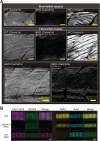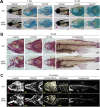Two zebrafish cacna1s loss-of-function variants provide models of mild and severe CACNA1S-related myopathy
- PMID: 37930228
- PMCID: PMC10800018
- DOI: 10.1093/hmg/ddad178
Two zebrafish cacna1s loss-of-function variants provide models of mild and severe CACNA1S-related myopathy
Abstract
CACNA1S-related myopathy, due to pathogenic variants in the CACNA1S gene, is a recently described congenital muscle disease. Disease associated variants result in loss of gene expression and/or reduction of Cav1.1 protein stability. There is an incomplete understanding of the underlying disease pathomechanisms and no effective therapies are currently available. A barrier to the study of this myopathy is the lack of a suitable animal model that phenocopies key aspects of the disease. To address this barrier, we generated knockouts of the two zebrafish CACNA1S paralogs, cacna1sa and cacna1sb. Double knockout fish exhibit severe weakness and early death, and are characterized by the absence of Cav1.1 α1 subunit expression, abnormal triad structure, and impaired excitation-contraction coupling, thus mirroring the severe form of human CACNA1S-related myopathy. A double mutant (cacna1sa homozygous, cacna1sb heterozygote) exhibits normal development, but displays reduced body size, abnormal facial structure, and cores on muscle pathologic examination, thus phenocopying the mild form of human CACNA1S-related myopathy. In summary, we generated and characterized the first cacna1s zebrafish loss-of-function mutants, and show them to be faithful models of severe and mild forms of human CACNA1S-related myopathy suitable for future mechanistic studies and therapy development.
Keywords: Cav1.1; congenital myopathy; excitation contraction coupling; zebrafish.
© The Author(s) 2023. Published by Oxford University Press. All rights reserved. For Permissions, please email: journals.permissions@oup.com.
Figures









References
-
- Campiglio M, Dyrda A, Tuinte WE. et al. Ca(V)1.1 calcium channel signaling complexes in excitation-contraction coupling: insights from channelopathies. Handb Exp Pharmacol 2023;279:3–39. - PubMed
-
- Ríos E, Pizarro G. Voltage sensor of excitation-contraction coupling in skeletal muscle. Physiol Rev 1991;71:849–908. - PubMed
-
- Miller TM, Dias da Silva MR, Miller HA. et al. Correlating phenotype and genotype in the periodic paralyses. Neurology 2004;63:1647–55. - PubMed
Publication types
MeSH terms
Substances
Grants and funding
LinkOut - more resources
Full Text Sources
Medical
Molecular Biology Databases

